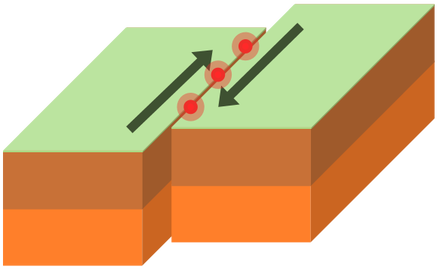EIS 12: Earthquake Simulator
In this lesson, you learned how the motion of tectonic plates, particularly at transform (sliding) boundaries, leads to earthquakes. For this EIS, you will model an earthquake using two blocks as tectonic plates. To create an earthquake, simply slide the two blocks back and forth against each other in the motion shown below. You can do this slowly for a mild earthquake or quickly for a strong one.
The goal of this experiment is to design a small house that can withstand a strong earthquake, without falling apart or tipping over. If you want an extra challenge, try building a skyscraper, city, or neighborhood instead.
It is recommended that you experiment with different building materials and designs. So, we ask that you build at least 3 buildings. They do not all have to survive your earthquake. Part of the experiment involves knowing what doesn’t work and then being able to make it better.
It is recommended that you experiment with different building materials and designs. So, we ask that you build at least 3 buildings. They do not all have to survive your earthquake. Part of the experiment involves knowing what doesn’t work and then being able to make it better.
Materials
- 2 blocks of any material. These should be relatively large but not so big that you can’t hold one in each hand.
- 6 x 8 x 3 inches is the recommended minimum size. It does not have to be exactly these proportions.
- Foam blocks, small-ish cardboard boxes, bricks, textbooks, cookbooks, encyclopedias, dictionaries, wood blocks, toy blocks, shoeboxes, and just about anything else that is around this size will do for this project. Both blocks should be about the same size.
- One or more small, lightweight building materials of your choice.
- Popsicle sticks, toothpicks, uncooked spaghetti, and straws are all recommended choices. Cardboard, cardstock, and paper may also be useful.
Procedure
- Construct a small building out of whatever materials you like. It should be small enough to fit comfortably on the blocks you are using as your tectonic plates.
- Put your building on the “ground” (the blocks you are using as tectonic plates).
- Simulate an earthquake by sliding the two blocks back and forth past each other. Start slowly and speed up until the building tips over or falls apart. Keep track of which buildings survive a while and which don’t.
- Do this for at least 3 buildings. Not all have to survive, but the goal is to experiment with different materials and building methods to make a stronger house each time. We encourage you to try to build a house that can withstand an earthquake without taping it to the box.
When you’re done, answer the associated questions. If you’re proud of your work, we want to see it! If you have an Instagram and the permission of your relevant responsible adult, share a photo or video with us @eons_learning, #EarthquakeEons. Have fun, and be creative!
